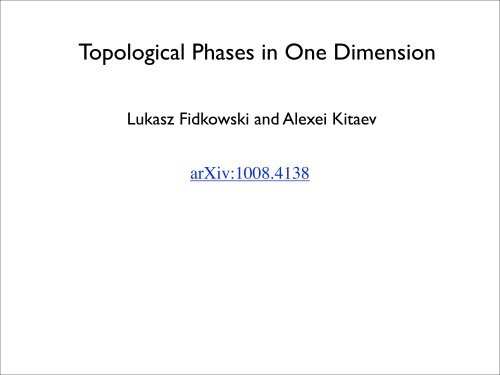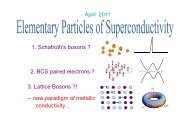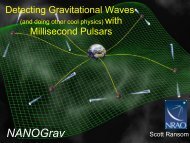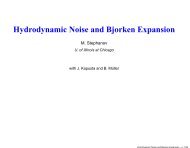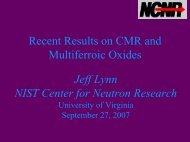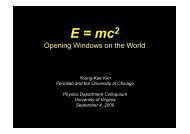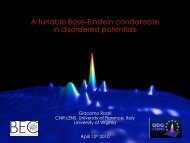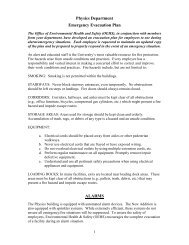Topological Phases in One Dimension
Topological Phases in One Dimension
Topological Phases in One Dimension
You also want an ePaper? Increase the reach of your titles
YUMPU automatically turns print PDFs into web optimized ePapers that Google loves.
<strong>Topological</strong> <strong>Phases</strong> <strong>in</strong> <strong>One</strong> <strong>Dimension</strong><br />
Lukasz Fidkowski and Alexei Kitaev<br />
arXiv:1008.4138
<strong>Topological</strong> phases <strong>in</strong> 2 dimensions:<br />
- Integer quantum Hall effect<br />
- quantized σ xy<br />
- robust chiral edge modes<br />
- Fractional quantum Hall effect<br />
- fractionally charged quasi-particles<br />
- robust chiral edge modes<br />
- Quantum sp<strong>in</strong> Hall, topological <strong>in</strong>sulators, etc.<br />
- free electrons, sp<strong>in</strong>-orbit coupl<strong>in</strong>g
The Majorana Wire<br />
- sp<strong>in</strong>-less p-wave superconductor<br />
- tight-b<strong>in</strong>d<strong>in</strong>g model:<br />
j =<br />
1 2 3 4 5 6<br />
(µ a † j a j + t(a j a † j+1 + a j+1a † j ) + ∆(a ja j+1 + a † j a† j+1 ) )<br />
H = ∑ j<br />
chemical<br />
potential<br />
hopp<strong>in</strong>g<br />
pair<strong>in</strong>g
Gapped Hamiltonians:<br />
“trivial” phase<br />
“topological” phase:<br />
protected Majorana<br />
edge modes<br />
phase transition
Re-write <strong>in</strong> terms of Majorana modes:<br />
〈a j , a † j 〉 〈c 2j−1, c 2j 〉<br />
c 2j−1 = −i(a j + a † j )<br />
c 2j = a j + a † j<br />
{a 1 , . . . , a N , a † 1 , . . . , a† N } {c 1 , . . . , c 2N }<br />
N fermion creation /<br />
annihilation operators<br />
2N Hermitian Majorana<br />
operators
- our Hamiltonian can then be written as a quadratic<br />
form <strong>in</strong> the Majoranas:<br />
2N∑<br />
H =<br />
A mn c m c n<br />
m,n=1<br />
- graphical representation:<br />
Hilbert Space:<br />
j =<br />
1 2 3<br />
c 1 c 2 c 3 c 4 c 5 c 6
Hamiltonian:<br />
c 1 c 2 c 3 c 4 c 5 c 6<br />
= i 2 (c 1c 2 + c 3 c 4 + c 5 c 6 )<br />
= a † 1 a 1 + a † 2 a 2 + a † 3 a 3 decoupled
trivial phase:<br />
c 1 c 2 c 3 c 4 c 5 c 6<br />
topological phase:<br />
c 1 c 2 c 3 c 4 c 5 c 6<br />
dangl<strong>in</strong>g Majorana modes<br />
a = 1 2 (c 1 + ic 6 )<br />
double ground state degeneracy<br />
a † = 1 2 (c 1 − ic 6 )
Recap:<br />
It<strong>in</strong>erant sp<strong>in</strong>-less fermions <strong>in</strong> one dimension have two<br />
phases. The non-trivial “topological” one is characterized<br />
by hav<strong>in</strong>g Majorana edge modes at its endpo<strong>in</strong>ts.<br />
What is left:<br />
1) <strong>in</strong>teractions?<br />
2) symmetries?<br />
either generic (like time reversal or particle-hole) or<br />
some arbitrary symmetry group G (like SU(2) <strong>in</strong> sp<strong>in</strong><br />
cha<strong>in</strong>s)
Majorana cha<strong>in</strong> with time reversal symmetry<br />
- sp<strong>in</strong>-less fermions as before, with<br />
T :<br />
a j → a j<br />
a † j → a† j<br />
T : c k → (−1) k c k<br />
- non-<strong>in</strong>teract<strong>in</strong>g (i.e. quadratic fermion) analysis gives<br />
<strong>in</strong>f<strong>in</strong>itely many phases, characterized by an <strong>in</strong>teger n∈ Z<br />
1 2 3 4 5 6 7 8
we showed that with <strong>in</strong>teractions,<br />
down to<br />
Z 8<br />
n → n mod 8<br />
Z<br />
is broken<br />
showed this by turn<strong>in</strong>g on quartic <strong>in</strong>teractions and<br />
f<strong>in</strong>d<strong>in</strong>g an explicit path <strong>in</strong> <strong>in</strong>teract<strong>in</strong>g Hamiltonian<br />
space which connects n and n+8.<br />
But how to handle <strong>in</strong>teractions <strong>in</strong> general?
Matrix Product States:<br />
- Bosonic sp<strong>in</strong> cha<strong>in</strong>s with local local sp<strong>in</strong>s s<br />
Ψ(s 1 , . . . , s N ) = Tr(A s1 . . . A sN )<br />
s i ∈ {−s/2, −s/2 + 1, . . . , s/2}<br />
A si<br />
: D × D matrices<br />
(can be generalized to fermionic systems via Jordan-Wigner<br />
transform)<br />
- Ground states of gapped Hamiltonians can be<br />
approximated arbitrarily well by MPS with small D<br />
(Hast<strong>in</strong>gs 2006)
Tensor network contraction picture:<br />
Closed MPS:<br />
Open MPS:<br />
s 1<br />
s 2<br />
s 3 s 4<br />
s 5<br />
s 9<br />
α<br />
α β β γ<br />
s 8<br />
s 1 s 2 s 3 s 4 s 5<br />
α β β γ γ<br />
s 7<br />
s 6<br />
α, β, γ ∈ {1, . . . , D}
Virtual degrees of freedom edge modes<br />
Theorem: If G is a symmetry of the orig<strong>in</strong>al states, then G has a<br />
projective action on the virtual degrees of freedom.<br />
(projective means that group relations are obeyed only up to<br />
phases, which one might not be able to gauge away)<br />
Thus, if G is a symmetry of the Hamiltonian, then there is a<br />
projective action of G on the edge modes.<br />
Generally, there is a discrete set of classes of projective<br />
representations of G, and these classes correspond to different<br />
phases. In fact, they enumerate all gapped phases of<br />
Hamiltonians with that symmetry group.
Example: AKLT Hamiltonian for sp<strong>in</strong>-1 Heisenberg model<br />
G = SO(3), but edge states <strong>in</strong> the non-trivial (Haldane) phase are<br />
half-<strong>in</strong>teger sp<strong>in</strong>s. These are representations of SU(2), and only<br />
projective representations of SO(3).<br />
Example: Majorana cha<strong>in</strong> with time reversal symmetry<br />
G = where P = (-1)^F<br />
If n mod 8 is the previously discussed topological <strong>in</strong>dex then:<br />
- n mod 2: P bosonic vs. fermionic<br />
- n mod 4: T commut<strong>in</strong>g/anti-commut<strong>in</strong>g with P<br />
- n mod 8: T^2 = +1 or T^2 = -1


